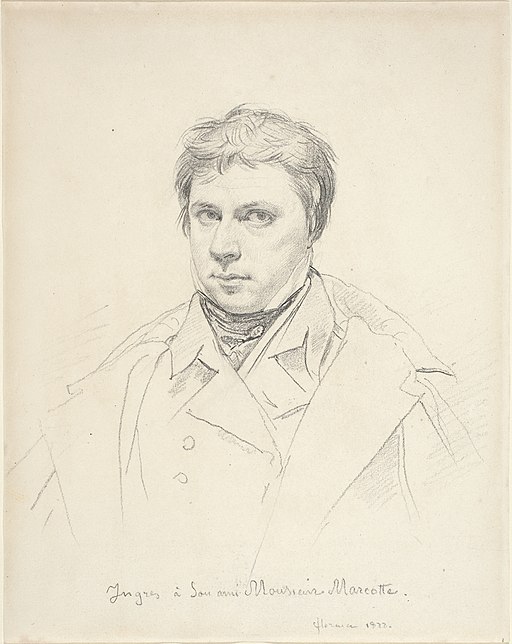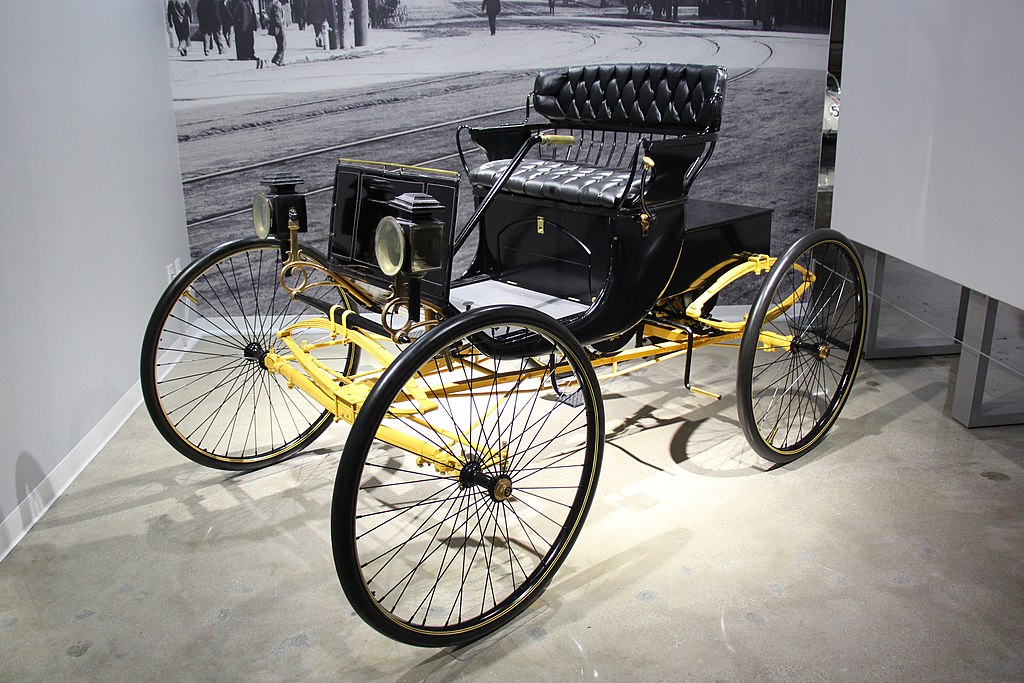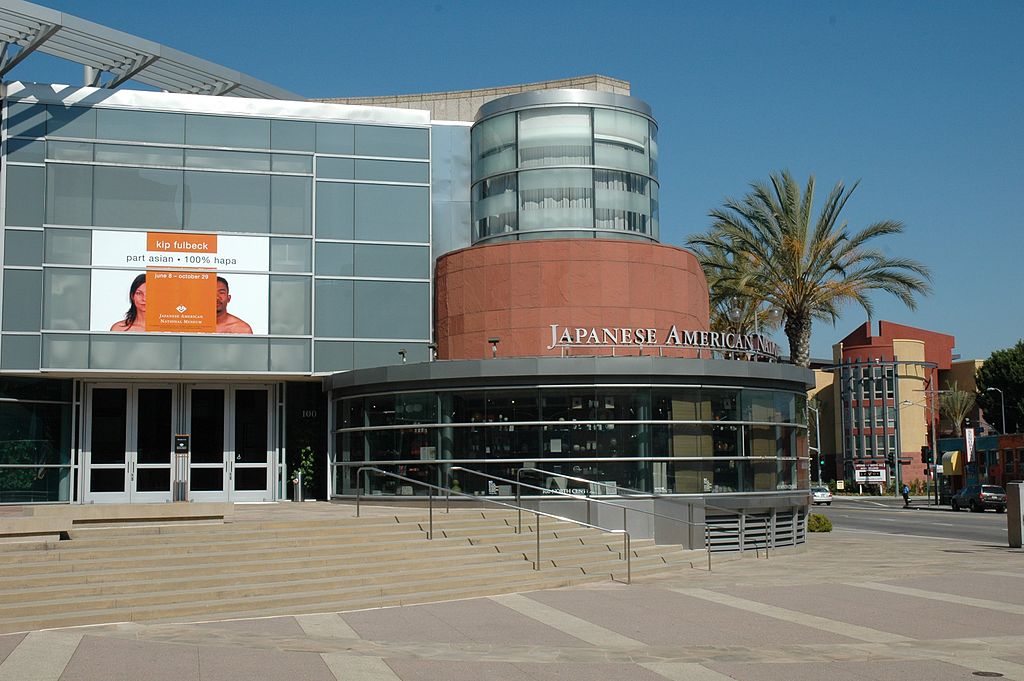
Jean-Auguste-Dominique Ingres (1780 – 1867) was a French Neoclassical painter who thought of himself as a painter of history and who today is highly regarded for his many portraits.
Critics often found his style bizarre and archaic. His expressive distortions of form and space make him an important precursor of modern art. His work influenced Picasso and Matisse and other modernists.
Virtual Tour of Jean-Auguste-Dominique Ingres
- Ruggiero Freeing Angelica
- The Valpinçon Bather
- The Turkish Bath
- Grande Odalisque
- Madame Moitessier ( The National Gallery, London)
- Madame Moitessier (National Gallery of Art, Washington, D.C.)
- Oedipus and the Sphinx (Louvre Museum)
- Oedipus and the Sphinx (Walters Art Museum)
Highlights Tour Jean-Auguste-Dominique Ingres
The Valpinçon Bather
“The Valpinçon Bather” by Jean-Auguste-Dominique Ingres is a female nude in a chaste pose. The curves accentuate her neck and the curves of her back and legs in the green draperies.
With the white linen in front of her and the folds of the bedsheets, this painting lacks the overt sexuality of other Ingres paintings.
Ingres has masterfully depicted a calm and measured sensuality, which is a masterpiece of harmony and light. Ingres returned to the form of this figure several times in his life. Museum: The Louvre
The Turkish Bath
“The Turkish Bath” by Jean-Auguste-Dominique Ingres depicts a group of nude women in the bath of a harem and is painted in a highly erotic style.
Ingres has successfully evoked the form of both the Near East and earlier western styles associated with the mythological subject matter.
Painted originally in a rectangular format, Ingres altered the painting by cutting the picture to its present tondo form. Fortunately, photographs of the art in its original size have survived. Museum: The Louvre
Grande Odalisque
“Grande Odalisque” by Jean-Auguste-Dominique Ingres depicts an odalisque. An odalisque was a chambermaid or attendant in the sequestered living quarters used by wives, court ladies, and concubines in an Ottoman household of the Ottoman sultan.
Grande Odalisque attracted extensive criticism when it was first exhibited. It became renowned for the elongated proportions and departure from the restrictions of anatomical realism.
This work signified Ingres’ break from Neoclassicism and shifted towards exotic Romanticism. Ingres favored long lines to convey curvature and sensuality and the very skillful use of light and shadow to sculpture proportions. Museum: The Louvre
Madame Moitessier ( The National Gallery, London)
“Madame Moitessier” by Jean-Auguste-Dominique Ingres is a portrait of Marie-Clotilde-Inès Moitessier (née de Foucauld) begun in 1844 but not completed until twelve years later.
Madame Moitessier (1821–1897) was the daughter of a French civil servant who married a wealthy banker and merchant, who was a widower twice her age.
In this painting, she is shown wearing abundant jewelry and dressed in an elegant silk dress with a floral pattern, which is echoed by the flowers and leaves of the gilt-framed mirrors.
Madame Moitessier is framed on either side by mirrors, and her profile reflection can be seen in the mirror on the right. Museum: The National Gallery, London
Madame Moitessier (National Gallery of Art, Washington, D.C.)
“Madame Moitessier” by Jean-Auguste-Dominique Ingres is a portrait of Marie-Clotilde-Inès Moitessier (née de Foucauld) completed in 1851 which depicts the subject standing in a black dress looking directly at the viewer.
Madame Moitessier (1821–1897) was the daughter of a French civil servant who married a wealthy banker and merchant, who was a widower twice her age. Museum: National Gallery of Art, Washington, D.C.
Ruggiero Freeing Angelica
“Ruggiero Freeing Angelica” by Jean-Auguste-Dominique Ingres was inspired by the 16th-century Italian epic poem called “Orlando Furioso” by Ariosto and depicted Ruggiero saving Angelica.
Ruggiero is portrayed as the knight riding a hippogriff, which is a legendary creature half horse and half eagle.
According to the poem, the hero is riding near Brittany’s coast, where he finds a beautiful woman who is chained to rock on the Isle of Tears.
She has been abducted and stripped naked by barbarians. She was left there as a human sacrifice to a sea monster. Museum: The Louvre
Oedipus and the Sphinx (Louvre Museum)
“Oedipus and the Sphinx” by Jean-Auguste-Dominique Ingres depicts Oedipus explaining the riddle of the Sphinx.
Oedipus was a tragic hero in Greek mythology. Oedipus accidentally fulfilled a prophecy in which he kills his father and unknowingly marries his mother.
As part of his journey, which brings disaster to his city and family, Oedipus encountered a Sphinx. The Sphinx would stop all travelers and ask them a riddle.
If the travelers did not answer the riddle correctly, they would be killed and eaten. If the answers were correct, they would be free to continue on their journey.
Oedipus and the Sphinx (Walters Art Museum)
“Oedipus and the Sphinx” by Jean-Auguste-Dominique depicts the Sphinx as it grimaces in horror as Oedipus solves her riddle. A Shinx is a mythical creature, part lion, part woman.
Ingres frequently repeated the subjects of his paintings, first depicted this story at the beginning of his career, and returned to it several times, making variations in the composition, such as reversing the direction in which the figures faced.
In 1864 Ingres painted this third version of Oedipus and the Sphinx, smaller than the first version, which reverses the composition and varies many details.
Jean-Auguste-Dominique Ingres
- Artist: Jean-Auguste-Dominique Ingres
- Born: 1780 – Montauban, Languedoc, France
- Died: 1867 (aged 86) – Paris, France
- Movement: Neoclassicism
- Masterpieces:
- Ruggiero Freeing Angelica
- The Valpinçon Bather
- The Turkish Bath
- Grande Odalisque
- Madame Moitessier ( The National Gallery, London)
- Madame Moitessier (National Gallery of Art, Washington, D.C.)
Jean Auguste Dominique Ingres: A collection of paintings
A Tour of Famous Artists you should Know
- Duccio (1255 – 1319)
- Jan van Eyck (1390 – 1441)
- Giovanni Bellini (1430 – 1516)
- Sandro Botticelli (1445 – 1510)
- Domenico Ghirlandaio (1448 – 1494)
- Leonardo da Vinci (1452 – 1519)
- Albrecht Durer (1471 – 1528)
- Lucas Cranach the Elder (1472 – 1553)
- Michelangelo (1475 – 1564)
- Raphael (1483 – 1520)
- Titian (1488 – 1576)
- Hans Holbein the Younger (1497 – 1543)
- Tintoretto (1518 – 1594)
- Pieter Bruegel the Elder (1525 – 1569)
- Paolo Veronese (1528 – 1588)
- El Greco (1541 – 1614)
- Caravaggio (1571 – 1610)
- Peter Paul Rubens (1577 – 1640)
- Georges de La Tour (1593 – 1652)
- Artemisia Gentileschi (1593 – 1656)
- Anthony van Dyck (1599 – 1641)
- Nicolas Poussin (1594 – 1665)
- Diego Velázquez (1599 – 1660)
- Rembrandt (1606 – 1669)
- Pieter de Hooch (1629 – 1684)
- Johannes Vermeer (1632 – 1675)
- Élisabeth Sophie Chéron (1648 – 1711)
- Canaletto (1697 – 1768)
- François Boucher (1703 – 1770)
- Jean-Honoré Fragonard (1732 – 1806)
- John Singleton Copley (1738 – 1815)
- Benjamin West (1738 – 1820)
- Angelica Kauffman (1741 – 1807)
- Francisco Goya (1746 – 1828)
- Jacques-Louis David (1748 – 1825)
- Antonio Canova (1757 – 1822)
- Katsushika Hokusai ( 1760 – 1849)
- Caspar David Friedrich (1774 – 1840)
- J.M.W. Turner (1775 – 1851)
- Jean-Auguste-Dominique Ingres (1780 – 1867)
- William Etty (1787 – 1849)
- Eugène Delacroix (1798 – 1863)
- George Caleb Bingham (1811 – 1879)
- Rosa Bonheur (1822 – 1899)
- Jean-Léon Gérôme (1824 – 1904)
- Dante Gabriel Rossetti (1828 – 1882)
- John Everett Millais (1829 – 1896)
- Frederic Leighton (1830 – 1896)
- Camille Pissarro (1830 – 1903 )
- Édouard Manet (1832 – 1883)
- James Abbott McNeill Whistler (1834 – 1903)
- Edgar Degas (1834 – 1917)
- James Tissot (1836 – 1902)
- Winslow Homer (1836 – 1910)
- Paul Cézanne (1839 – 1906)
- Auguste Rodin (1840 – 1917)
- Claude Monet (1840 – 1926)
- Pierre-Auguste Renoir (1841 – 1919)
- Berthe Morisot (1841 – 1895)
- Henri Rousseau (1844 – 1910)
- Mary Cassatt (1844 – 1926)
- Elizabeth Thompson (1846 – 1933)
- Gustave Caillebotte (1848 – 1894)
- Paul Gauguin (1848 – 1903)
- John William Waterhouse (1849 – 1917)
- Jean Béraud (1849 – 1935)
- Vincent van Gogh (1853 – 1890)
- Frederick McCubbin (1855 – 1917)
- John Singer Sargent (1856 – 1925)
- Tom Roberts (1856 – 1931)
- Lovis Corinth (1858 – 1925)
- Georges Seurat (1859 – 1891)
- Gustav Klimt (1862 – 1918)
- Edvard Munch (1863 – 1944)
- Henri de Toulouse-Lautrec (1864 – 1901)
- Rupert Bunny (1864 – 1947)
- Wassily Kandinsky (1866 – 1944)
- Arthur Streeton (1867 – 1943)
- Pierre Bonnard (1867 – 1947)
- Franz Marc (1880 – 1916)
- Goyō Hashiguchi (1880 – 1921)
- George Bellows (1882 – 1925)
- Edward Hopper (1882 – 1967)
- Amedeo Modigliani (1884 – 1920)
- Fernando Botero (born 1932)
- Artists and their Art
- Women in the Arts
- Famous French Painters You Should Know
Jean-Auguste-Dominique Ingres
Famous Women in the Arts
- Élisabeth Sophie Chéron (1648 – 1711)
- Artemisia Gentileschi (1593 – 1656)
- Louise Élisabeth Vigée Le Brun ( 1755 – 1842)
- Marie-Denise Villers (1774 – 1821)
- Rosa Bonheur (1822 – 1899)
- Sophie Gengembre Anderson (1823 – 1903)
- Berthe Morisot (1841 – 1895)
- Mary Cassatt (1844 – 1926)
- Anna Lea Merritt (1844 – 1930)
- Elizabeth Thompson (1846 – 1933)
- Margaret Bernadine Hall (1863 – 1910)
- Artists and their Art
- Women in the Arts
Ingres’s Madame Moitessier
Jean-Auguste-Dominique Ingres Quotes
~~~
“Is there anyone among the great men who have not imitated? Nothing is made with nothing.”
~~~
“Make copies, young man, many copies. You can only become a good artist by copying the masters.”
~~~
“What do these so-called artists mean when they preach the discovery of the’new’?
Is there anything new? Everything has been done; everything has been discovered.”
~~~
“You have to observe flowers to find the right tones for the folds of clothes.”
~~~
“It takes 25 years to learn to draw, one hour to learn to paint.”
~~~
Jean-Auguste-Dominique Ingres, “Comtesse d’Haussonville”
Jean-Auguste-Dominique Ingres – The Duke of Orléans
~~~
“Is there anyone among the great men who have not imitated? Nothing is made with nothing.”
– Ingres
~~~
Photo Credit 1) Jean Auguste Dominique Ingres [Public domain]
Top Posts & Pages








 Sponsor your Favorite Page
Sponsor your Favorite Page SEARCH Search for: Search Follow UsJoin – The JOM Membership Program
Become a Patron!
Sponsor a Masterpiece with YOUR NAME CHOICE for $5
Share this:
- Tweet
